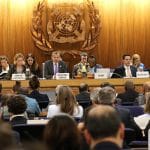The resumed meeting of the parties to the UN’s COP16 Global Biodiversity Conference in Rome has reached agreement, after intense negotiations, on a landmark deal to mobilize billions of dollars to fund nature protection.
Bringing the business of the UN Biodiversity Conference, COP16 that was suspended in Cali, Colombia in 2024, to a successful close, governments agreed on February 28 on the strategy to raise the funds needed to protect biodiversity and to achieve the action targets of the Kunming-Montreal Global Biodiversity Framework (KMGBF), agreed in Montreal at COP15 in 2022.
At the COP16 UN biodiversity conference in Cali, Colombia, the parties agreed on an expanded role of Indigenous Peoples and local communities in saving biodiversity and a groundbreaking agreement on the operationalization of a new global mechanism to share benefits from digital genetic information. However, on the morning of November 2, 2024, after 24 hours of final negotiations, discussions around the establishment of a new wider biodiversity fund, as well as other key decisions, were postponed and the meeting suspended because there were no longer enough negotiators remaining in the room to reach decisions (quorum was lost).
Under the KMGBF, 196 countries agreed to halt and reverse global biodiversity loss by 2030. Despite having helped draft the Global Biodiversity Framework, the U.S. is not an official member of the Convention on Biological Diversity (CBD), a UN treaty meant to stop and reverse the decline of wildlife.
“These days of work in Rome have demonstrated the commitment of the Parties to advance the implementation of the Global Biodiversity Framework. The COP16 presidency recognises the collective effort to reach consensus of key issues that were left pending in Cali,” COP16 President Susana Muhamad said. “We appreciate the willingness of all countries and the Secretariat of the Convention for their dedication to continue strengthening the global biodiversity agenda. Only by working together can we make peace with nature a reality.”
Convention on Biological Diversity Executive Secretary Astrid Schomaker said the results of this meeting show that multilateralism works and is the vehicle to build the partnerships needed to protect biodiversity. She encouraged Parties to draw on the latest assessments for a surge in the KMGBF implementation.
#COP16Colombia + #COP16Resumed has been an exceptional @UNBiodiversity Conference with the largest mobilization in the history of the Convention and Protocols.
Action keeps multilateralism alive.
We will arrive in Yerevan with an action-oriented mindset for #PeaceWithNature. https://t.co/VzmBDhqcDQ
— Astrid Schomaker (@SchomakerAstrid) February 28, 2025
Parties to the Convention agreed on a way forward in terms of resource mobilization with a view to close the global biodiversity finance gap and achieve the target of mobilizing at least $200 billion a year by 2030, including $20 billion a year in international flows by 2025, rising to $30 billion by 2030.
The European Commission welcomed the deal, noting that negotiations demonstrated the global community’s strong support for the swift implementation of the Global Biodiversity Framework (GBF).
“I welcome the positive outcome of the global biodiversity negotiations in Rome. An agreement has been reached on all outstanding issues,” EU Environment, Water Resilience and a Competitive Circular Economy Commissioner Jessika Roswall said. “We have secured a global roadmap to support financing for biodiversity beyond 2030. This is proof that multilateralism works, despite a difficult international geopolitical context and multiple global challenges. Working closely together, all Parties agreed on a roadmap for the mobilisation of resources to close the biodiversity financing gap,” Roswall said, adding that agreement was also reached on the monitoring framework and the procedures for the global review of implementation of the Global Biodiversity Framework at the next COP17 Global Biodiversity Conference.
Cali Fund launched
The newly established Cali Fund was also launched. “Now, companies benefiting from digital sequence information on genetic resources can share some of the proceeds with biodiverse countries of origin, with half of the fund allocated to Indigenous Peoples and local communities. These achievements show that despite a fragmented geopolitical landscape, the global community chose to come together to halt and reverse biodiversity loss. And we all did this with a spirit of compromise, openness and flexibility,” Roswall said.
“It is crucial that we build on the good work done and maintain momentum to implement the Global Biodiversity Framework (GBF),” the EU Commissioner said. Countries around the world embarked on such implementation by revising their national biodiversity strategies and action plans and setting national targets. “This momentum should continue. The EU will continue working with countries worldwide, to find solutions and continue implementing this historic agreement until 2030 and beyond,” she said.
Parties adopted a Strategy for Resource Mobilisation that identifies a broad range of instruments, mechanisms and institutions that could be tapped to mobilise the funds needed to implement the GBF.
Parties also enhanced the monitoring framework for the GBF, agreed upon at COP15. The monitoring framework is essential for implementing the Framework because it provides the common yardstick that Parties will use to measure progress against the 23 targets and 4 goals.
At COP16, Parties agreed on the way that the indicators would be measured and used. This will ensure that all Parties track progress in a way that national policy makers can interpret, and it will provide data that can be aggregated up to the global level to provide a worldwide picture of implementation.
Parties also took important decisions on how progress in the implementation of the GBF will be reviewed at COP17 as part of the planned global stock take.
The Global Biodiversity Framework agreed in 2022 provides clear goals and targets, and a roadmap to protect and restore biodiversity worldwide. Currently, 46 countries have submitted revised National Biodiversity Strategies and Action Plans (NBSAPs), and 124 countries have uploaded their national targets to the online reporting tool. The next Conference of the Parties will take place in 2026 in Yerevan, Armenia.








